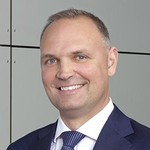Thomas Praska and Joachim Stengel on patient benefit as the North Star metric, data-based innovations and the importance of patient communities for treatment success
Emergence and variants
of patient communities
Turning points start with a change of perspective and the questioning of established positions in the system. Such a shift is emerging in the healthcare sector today. Digital communities are changing the way patients and their relatives interact with each other – and opening up new ways of cooperating with pharmaceutical manufacturers, clinics and physicians. Together, they can harness the potential of digitalization, ease the cost pressure in the development of new medications and treatment methods with smart therapy-accompanying models and support the development of groundbreaking biotechnologies.
Mr. Praska, Mr. Stengel, is the taxonomy of healthcare changing right now?
Thomas Praska: Yes, we are witnessing an extremely profound change that started several years ago. The development of innovative therapy options requires even greater investment, and there are fewer and fewer blockbusters. The progress in individual medicine is very impressive, but the treatments are enormously cost intensive. And, of course, healthcare systems are under severe pressure from demographic change. Against this background, everything must be done to make therapies as efficient and successful as possible. However, this task requires a much closer cooperation with patients than has been possible in the past.
Digitalization opens up immense opportunities here: For a better understanding of patient's life circumstances, for sharing experiences, for optimal organization of treatment. Digitally organized patient communities play a crucial role in this. An ecosystem is thus created around the patient, which enables a holistic perspective on the entire context of the therapy. I think that the sustainability of healthcare systems will depend heavily on how well we develop such cooperation models and how the use of the data generated in such structures can be organized. Data protection aspects must play just as much a role here as the possibilities of using the insights arising from the data for the benefit of patients.

„An ecosystem is created around the patient, which enables a holistic perspective on the entire therapy context.“
How would you describe the establishment of such communities?
Joachim Stengel: The topic is especially relevant in the case of particularly severe, often chronic diseases. Here, patients are confronted with a multitude of questions – what does the diagnosis mean for me? What are the experiences of other sufferers? Some chronic diseases increasingly affect specific demographic groups; multiple sclerosis (MS), for example, affects young women. Then when a particular compound is used as a medication, a group of people with similar challenges, questions and needs can quickly emerge and organize into forums and groups.
Another scenario concerns very rare diseases, for some of which there are hardly any approved medications or treatment methods. The level of structuring here can be very high up to the establishment as an association, multi-local structures and a kind of governance. An example of this is spinal muscular atrophy (SMA). Babies and young children are particularly affected here, so it is mainly their parents who are organized in the communities, which work very actively and closely with the pharmaceutical industry to carry out studies and accelerate developments.
In addition to the more loose networks and structured communities, there are also communities organized by manufacturers around particular support services, information or products.
Thomas Praska: The example of SMA also illustrates the central importance of relatives. In the case of many severe and chronic diseases, the direct environment of those affected organizes itself. After all, patients also go through an emotional curve during the course of the disease and the direct environment, family and friends want and need to help and support. And this outer circle sometimes organizes itself into individual communities and plays an important role.
An interview with
More topics
Cooperation with pharmaceutical manufacturers
What do pharmaceutical manufacturers expect from the dialog with these groups?
Thomas Praska: In the healthcare system, the focus is broadening in the direction of actual and measurable patient benefit which encompasses more than effective medicine. For example, the question of the patient's concomitant life circumstances, of taking medication as prescribed, of the involvement of relatives. The pharmaceutic industry has no influence on these factors and of course it has only limited insight because this knowledge cannot be generated by clinical studies. This is why collaboration with patients and their communities, which accumulate experience, is imperative here.

„In the healthcare system, the focus is broadening in the direction of patient benefit which encompasses more than effective medicine.“
Is this cooperation also a way to improve patient compliance, i.e. the correct use of the prescribed therapy?
Thomas Praska: This is a very important aspect. Because a huge chunk of the entire patient costs is generated by the incorrect use of prescribed medicine. This is a very complex question that unfortunately cannot be solved by an alert on a smartphone. Such as when chemotherapy is interrupted for the summer so that the patient can recover his or her vitality. Because oncologists know that the success of the treatment also depends heavily on achieving a positive mental health in patients. But this interruption can also have side effects. And this requires very complex considerations in which the exchange and experience of other patients and their relatives play a major role.
These difficult considerations also relate, for example, to the question of the form of administration. For many patients and relatives, receiving regular infusions in a clinic is a source of stress. They would therefore find a different form of administration a great benefit. But unfortunately, a gentle form of administration is usually less effective than an infusion. In such borderline cases, it is a matter of generating knowledge and understanding in order to design an optimal form of therapy and also to keep an eye on the reimbursement framework so that the therapies also remain financially viable.
For all of this, you need as comprehensive a data basis as possible and that not only contains clinical data but also enables a differentiated view of the use of the therapeutics and the context of this use.
Joachim Stengel: The more serious the diagnosis – especially of chronic diseases – the more important it is to optimally integrate the therapy into the patient's life model, to understand which emotional phases they go through, how willing they are to intensively engage with treatment and to actively use the therapy. The exchange with other patients can be very helpful. And the insights that emerge in such communities can help the pharmaceutical industry to develop valuable therapy-supporting measures in which digitalization plays a leading role. A good example of this is digital tools that complement blood sugar monitoring devices and make it easier to regularly measure, collect, transmit and analyze readings, helping patients to use their therapy more effectively and manage their daily lives better.

„To successfully integrate patient groups and individual patients in communication, a community framework is imperative.“
Organizational and legal requirements
Are there organizational and legal requirements that play a role in the interaction with patient groups?
Joachim Stengel: Working with patient communities is complex in many respects, especially if you are a company that operates an open community. On the one hand, a very elaborate, continuous monitoring of all communication channels, for example, also of social media presence, is required, with a special focus on adverse events. For example, when unexpected side effects are reported, or when a study that was conducted with the participation of the community is not successful. This can have very strong emotional effects that need to be dealt with. That's why the pharmaceutical industry tries to keep the number of channels to a manageable level.
On the other hand, we tend to rely on closed communities that are integrated into our own ecosystem This can be done, for example, via an app that requires registration, which acts as an interface between patient, the attending physician, the manufacturer and also other patients. The contents and processes are often managed by a service provider to simplify organizational and regulatory aspects. In any case, a kind of framework is needed to organize collaboration and integrate both patient groups and individual patients into communication structures.

„In recent years, a number of mini-ecosystems have been created around patients, especially for chronic diseases.“
What does this mean for the direct interaction with the patient?
Thomas Praska: For pharmaceutical companies, the effective administration of therapies with the greatest possible benefit for the patient forms the core of their identity. But for decades, industry's contribution was limited to the development of therapies and the technical optimization of their use. Access to the patients' living environments was difficult because there were hardly any direct points of contact. On the one hand, this was due to a lack of opportunities for interaction and, on the other, to relatively rigid structures and roles in the healthcare system. This meant there was no connection to the "last mile” in the therapy process, which, however, is essential to the success of the treatment.
In the last ten or fifteen years, pharmaceutical manufacturers have therefore increasingly worked on forming mini-ecosystems around patients, particularly in the case of chronic diseases, and building this missing link. This can be illustrated by the example of a nurse service for MS diseases, which is already very well established in some countries. When a patient is to be started on a drug for the first time, she can register for a free nurse service. She is then contacted by a nurse, who works with the manufacturer and schedules a personal appointment. At this appointment, the nurse explains to the patient how and where to administer the drug correctly and painlessly, what to do in an emergency and how to prepare for travel. She/he answers individual questions and may also leave a cooling device for the drug.
With such gentle approaches, with partners, you can build an ecosystem around the patients. Digitalization opens up enormously exciting opportunities to expand such systems, to network with communities, to raise interaction to another level.
Joachim Stengel: Interaction with patients and patient communities enables manufacturers to achieve a better understanding of patients and to focus even more strongly on patient benefit. In larger pharmaceutical companies, we are seeing more and more frequently that dedicated units dealing with the topic of patient engagement and patient partnership are being set up. These patient partnership managers also have the necessary cultural skills. They then determine, on the basis of governance, which channels are to be kept open and how communication can be structured. This requires a very high level of sensitivity because these are not communities that are formed around hobbies.
Future development
Will patient communities play a greater role in healthcare? Will they perhaps even have to?
Thomas Praska: In the past, patient communities tended to operate on the periphery of the healthcare system – but this is increasingly changing. And if the industry works more closely with patient communities in the future, for example to improve products or medications on the basis of evidence-based data, they will move much more into the center. At the same time, however, they lack the expertise to interpret healthcare data and use it productively. So in the future, it will be about generating and evaluating diverse together, in an ecosystem of different groups. These include the patient, his or her environment and communities, the attending nurse, the attending physician, the research-based pharmaceutical company, hospitals and outpatient clinics. That's one direction.
Joachim Stengel: Another is prevention, which also stands or falls with the participation and early involvement of patients and patient groups. The healthcare system today is designed to treat patients, not prevent disease. The big question is how to effectively include patient communities into a system that is complex, highly structured and difficult to coordinate.

„Is a paradigm shift taking place in the healthcare system toward a focus on treatment success? This would strengthen the future importance of patient communities.“
Is further development of this highly structured system at all realistic?
Joachim Stengel: I strongly believe in the ability of the healthcare system to change – even if the change is slow and does not occur without external stimulation. A paradigm shift toward a focus on treatment success is crucial. Some national healthcare systems have already initiated this change. If maintaining health rather than treating disease becomes the guiding principle – then change will also be possible. And under these organizing principles, the role of patients and patient communities will also become significantly more important because prevention is closely tied to everyday-life and psychological aspects, on which peer groups have a very positive impact.
If patient benefit and prevention are established as the new guiding principles of healthcare – won't this also create conditions for new strong players to enter the ecosystem?
Thomas Praska: If the major technology companies achieve a breakthrough in the direction of prevention and patient care, the coordinates will change. It will be exciting to see how Google Health, for example, develops. BigTech could directly leverage their communities, their data knowledge and their competences in building ecosystems. Because patients are highly likely to be willing to make their data available for diagnosis and prevention. Which in turn can lead to a significant strengthening of the patient community in the overall system. You are only strong if you have the opportunity to take responsibility. And patients can take responsibility especially on the prevention side.
Don't the legal requirements surrounding data use and data protection work against this development?
Thomas Praska: In this context, it is essential to avoid polarization and engage in a broad and open dialog. It goes without saying that careful and rule-based handling of patient data is important. Otherwise, there will be no mutual trust in the system. At the same time, however, we have to accept that data-based innovations are not born from rules governing their use, but from the use itself. And if this use becomes so restrictive and complicated that is no longer possible to define a business case, the last mile will remain out of reach. This is certainly not in the interest of the patients and society, which needs to make its healthcare sustainable and future-proof .
Im Interview
-

Roadmap: digital healthcare applications
Mastering the DiGA journey from the idea to a finished app.
- 1
-

„Resources and responsibility must follow knowledge.“
Michael Kandel on distributed innovation processes, the decentralization of decision-making authority and how to maintain stability in the face of change.
- 1
-

„Wer Ökosysteme kontrollieren will,verhindert ihre Entwicklung.“
Manuel Audi und Florian Weihe über Minimum Viable Ecosystems, die zentrale Bedeutung von Purpose und die Frage, warum Technologie kein entscheidender Faktor für den Erfolg von Ökosystemen ist.
- 1






